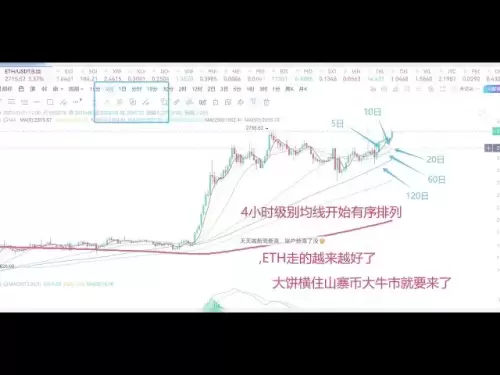 |
|
 |
|
 |
|
 |
|
 |
|
 |
|
 |
|
 |
|
 |
|
 |
|
 |
|
 |
|
 |
|
 |
|
 |
|
Cryptocurrency News Articles
Warren Buffett Is Now Deep Value Investing in Japan's 5 Biggest Trading Houses
Apr 22, 2025 at 04:30 am
Warren Buffett told a classroom full of business students in Florida in 1998 that Japan made no sense to him as an investor.

In 1998, at the peak of Japan’s Lost Decade, billionaire investor Warren Buffett told a classroom full of business students in Florida that the country didn’t make sense to him.
Back then, Berkshire Hathaway (NYSE:) could borrow for ten years at just 1% in Japan, and all he needed to do was beat that rate to profit.
“So far, I haven’t found anything,” Warren told them. “Japanese companies earn very low returns on equity. But as long as money is 1%, I’ll keep looking.” That was his take during Japan’s dead economy era.
But now in 2025, at the age of 93, the billionaire investor isn’t just looking—he’s buried deep with $23.5 billion locked in five Japanese trading giants while cutting his exposure to the United States.
The billionaire investor made those comments during Japan’s Lost Decade, when the Bank of Japan kept interest rates near zero to fight off long-term economic slowdown. Money was cheap, but Buffett wasn’t impressed. He didn’t want to deal with the risk of investing in companies with weak earnings.
And he wasn’t ready to hedge currency or gamble on the yen. His investment style followed Benjamin Graham’s “margin of safety” idea. For him, it wasn’t about how cheap the loans were—it was about how bad the returns were.
“If you’re in a lousy business for a long time, you’re going to get a lousy result,” Buffett said later that day. For him, the math didn’t work in Japan.
Fast forward to today, and Buffett has done a full 180. This year, Berkshire Hathaway (NYSE:) reported that it now owns nearly 10% in each of five Japanese trading firms—Itochu, Marubeni, Mitsubishi, Mitsui, and Sumitomo.
That level of ownership in a foreign country is rare for Buffett, but it shows where he’s placing his bet now. Buffett first began buying into these trading houses in 2019, but the world found out in 2020—on Buffett’s 90th birthday.
He picked the firms because they act like diversified machines, touching sectors from energy and shipping to retail and food. In other words, they look a lot like Berkshire itself. What drew him in? Reliable dividends, strong cash flow, and tight spending.
And the same low rates that turned him off in 1998 are now helping him lock in profits. Buffett financed the move by selling yen-denominated debt—cheap loans in Japan’s weak currency—and used the money to buy companies paying solid returns.
In 2024, Buffett wrote to shareholders that he’d gotten permission from the five companies to go past Japan’s usual 10% ceiling, something few foreign investors are allowed to do. At the end of the year, the total value of his holdings in the five firms was $23.5 billion, and he had only paid $13.8 billion for them.
That’s a profit of nearly $10 billion, straight off the playbook Buffett used to run in the U.S. But he wasn’t wrong to be cautious before. Currency risk is still a threat. The carry trade—borrowing cheap yen and investing it elsewhere—has collapsed before.
Between 2022 and 2023, U.S. Treasury yields spiked, the yen surged, and investors panicked. That sudden wave caused serious losses across Asian stock markets and currencies.
Now, the Bank of Japan has even more pressure. Inflation expectations in Japan jumped again over the last three months. A BOJ survey released on Friday showed 86.7% of households now believe prices will go up in the next year.
That’s the highest number since June 2024, and up from 85.7% in December. The same data showed Japanese companies are finally raising wages and prices—two things the central bank has been trying to trigger for years.
The BOJ had been leaning toward raising rates. All the signs are there. Wages are up. Prices are climbing. And inflation expectations keep pushing higher. That’s the kind of thing that normally leads to hikes.
But for now, interest rates in Japan are still low. And Buffett’s still collecting dividends off debt that costs next to nothing. He passed on Japan once. But this time, he’s not walking away.
Disclaimer:info@kdj.com
The information provided is not trading advice. kdj.com does not assume any responsibility for any investments made based on the information provided in this article. Cryptocurrencies are highly volatile and it is highly recommended that you invest with caution after thorough research!
If you believe that the content used on this website infringes your copyright, please contact us immediately (info@kdj.com) and we will delete it promptly.
-

-

-

-

-

-

-

-

- Major U.S. Banks Are In Early Talks To Launch a Joint Stablecoin to Challenge Tether and Circle's Dominance
- May 23, 2025 at 09:55 pm
- Major U.S. banks are weighing forming a potential consortium to issue a joint stablecoin to challenge the dominance of Tether and Circle's stranglehold over the ballooning $245 billion stablecoin market.
-



























































